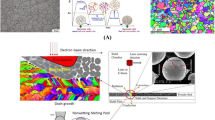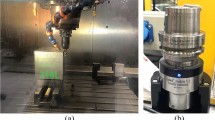Abstract
Post-machining part distortions are commonly observed in thin-walled machined structures. This problem is intensified if the machined part is cellular, curved in profile, and complex in design. Different customized techniques are executed to overcome this issue and to attain the desired dimensional accuracy. This problem instigates mainly due to redistribution of material-induced residual stress subsequent to machining operations. Research work presented here deals with numerical and experimental investigations of part distortions encountered in thin-walled machined structures. Computational analysis and manufacturing simulations of cutting operations are executed in ANSYS® software. Computational work is validated through actual experimentation on a computerized numerical controlled machine with optimum cutting parameters. Coordinate measuring machine (CMM) geometric inspection is carried out to determine the attained machining accuracy. Material-induced residual stress is developed through sequential coupled field thermo-mechanical analysis. Large-scale cutting simulations are performed in an optimized sequence by employing element birth–death feature. Simulation predicted distortions and CMM statistics is evaluated, and it was found that both corroborate with each other. This validates the approach adopted to predict part distortions.
















Similar content being viewed by others
References
Sandberg M, Larsson T, Astrom P, Nasstrom M (2005) A design tool integrating cad and virtual manufacturing for distortion assessment. Proceedings of 15th international conference on engineering design, ICDE 05, Melbourne
Yu W, Wang W (2007) Computer simulation and experimental study of machining deflection due to original residual stress of aerospace thin-walled parts. Int J Adv Manuf Technol 33(3-4):260–265
Mura T (1982) Micro-mechanics of defects in solids. Martinus Publishers, Netherlands
ASM International (1991) ASM handbook: Heat treating, vol 4. ASM International, pp 1905–1949. ISBN 0-87170-379-3
Nervi S, Szabo BA (2007) On the estimation of residual stresses by the crack compliance method. Comput Methods Appl Mech Eng 196:3577–3584
Cheng W, Finnie I (2007) Residual stress measurement and the slitting method. Springer, New York
Hilley ME et al (1971) Residual stress measurement by X-ray diffraction. SAE J784a. Society of Automotive Engineers, Warrendale
Brinksmeier E et al (1982) Residual stresses measurement and causes in machining processes. Ann CIRP 31(2):491–510
Sai B (2001) Influence of machining by finishing milling on surface characteristics. Int J Mach Tools Manuf 41(3):443–450
Cappello E, Davoli (2000) The influence of turning parameters on residual stress. Proceedings ICRS 10.-12.7.2000
Brown S, Song H (1992) Implication of three-dimensional numerical simulation of welding of large structures. Weld J 71(2):55s–62s
Rohde Jeppsson (2000) Literature review of heat treatment simulations with respect to phase transformation, residual stresses and distortion. Scand J Metall 29(2):47–62
Denis S, Archambault P, Gautier E, Simon A, Beck G (2002) Prediction of residual stress and distortion of ferrous and non-ferrous metals. J. Mater Eng Perform 11(1):92–102
Walker D, Hom RY (2002) Residual stress analysis of aircraft aluminum forgings. Adv Mater Process 160(6):57–60
Webster GA, Ezeilo AN (2001) Residual stress distributions and their influence of fatigue lifetimes. J Fatigue 23:S375–383
Liu CR, Yang X (2001) The scatter of surface residual stresses produced by face-turning and grinding. Mach Sci Technol 5(1):1–21
Newborn MA, Schultz RW (2001) The influence of residual stress in quenched 2024 bar stock on machining distortion. Alcoa internal publication
Acknowledgements
This work was funded by the Deanship of Scientific Research (DSR), King Abdulaziz University, Jeddah, under Grant No. 966-370-D1435. The authors, therefore, acknowledge with thanks DSR technical and financial support.
Author information
Authors and Affiliations
Corresponding author
Additional information
Technical Editor: Alexandre Mendes Abrao.
Rights and permissions
About this article
Cite this article
Awan, W.S., Mabrouki, T. Numerical and experimental investigations of post-machining distortions in thin machined structures considering material-induced residual stress. J Braz. Soc. Mech. Sci. Eng. 39, 509–521 (2017). https://doi.org/10.1007/s40430-015-0386-5
Received:
Accepted:
Published:
Issue Date:
DOI: https://doi.org/10.1007/s40430-015-0386-5




